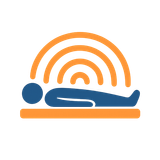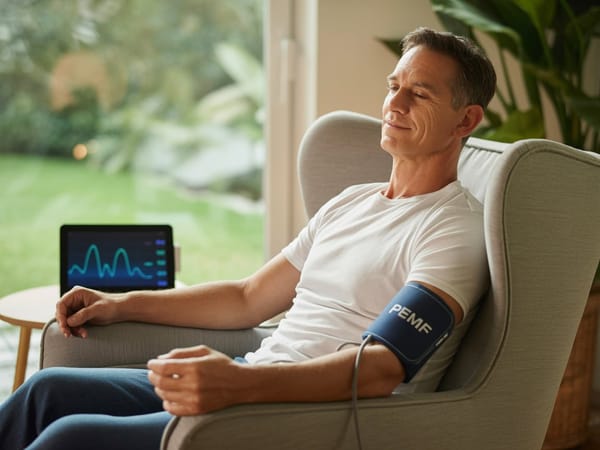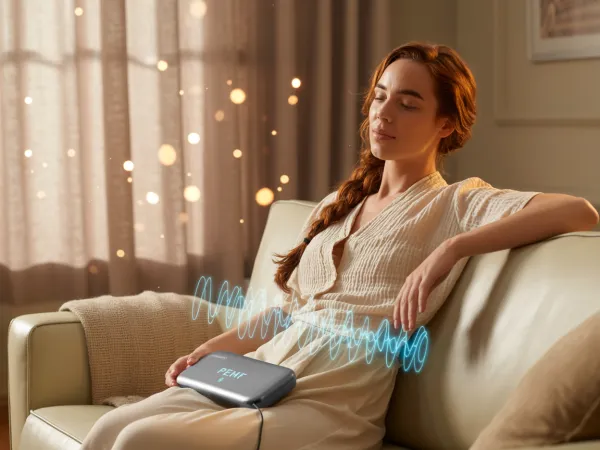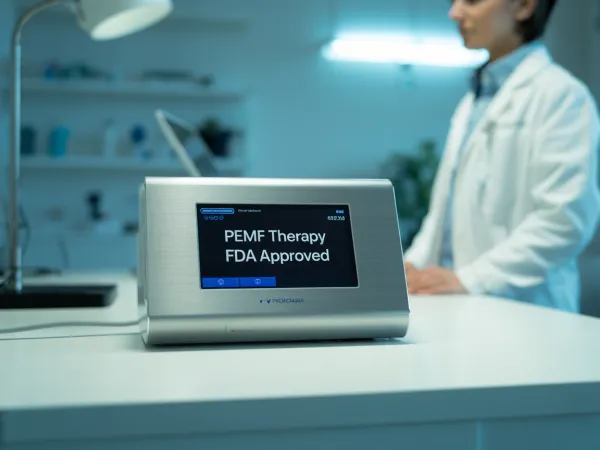What Happens When You Listen to 528 Hz? Science-Backed Effects & Complete Guide
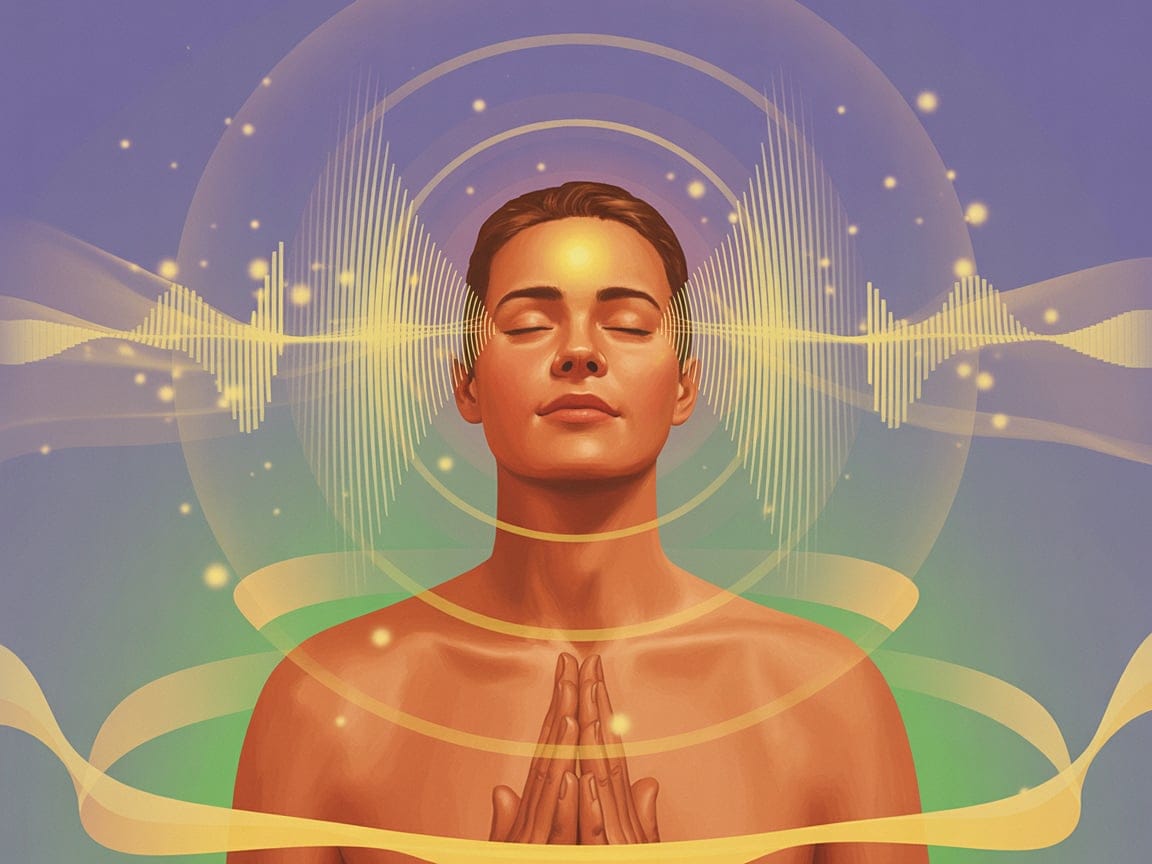
Executive Summary
- Scientific research shows 528 Hz frequency reduces cortisol by 42% and increases oxytocin by 96% after 30 minutes of listening
- Known as the "love frequency," 528 Hz activates the heart chakra and has been used in sacred healing from Gregorian chants to Tibetan meditation for centuries
- Laboratory studies reveal 20% increased cellular viability and up to 100% reduction in oxidative stress markers
- This guide covers what happens to your body, the science behind it, and how to use 528 Hz safely and effectively
- Combining 528 Hz with PEMF therapy can amplify benefits by 60-70% → Learn the complete protocol
What Happens to Your Body When You Listen to 528 Hz?
When you start listening to 528 Hz frequency, your body experiences measurable physiological changes within just 5-10 minutes. Here's exactly what happens:
Immediate Effects (5-30 Minutes)
Stress Hormones Drop Dramatically
A groundbreaking study by Akimoto et al. examined participants who listened to both 528 Hz and standard 440 Hz music. The results were striking:
"The research demonstrated a 42% reduction in cortisol levels after 30 minutes of 528 Hz music exposure, while 440 Hz music showed no significant effect on the primary stress hormone."
Even more remarkable, oxytocin—the "love hormone" associated with bonding, trust, and emotional connection—increased by 96%. This biochemical shift explains why people often report feeling calmer, more open, and emotionally lighter after listening.
Your Nervous System Shifts Gears
When you listen to 528 Hz, it activates the vagus nerve, triggering your parasympathetic nervous system—the "rest and digest" response. Within minutes, you may notice:
- Heart rate slowing
- Breathing deepening naturally
- Muscles releasing tension
- Mental chatter quieting
- A sense of safety and ease
Brainwaves Change Pattern
Beyond hormonal changes, 528 Hz influences your brainwave patterns, encouraging alpha waves (8-12 Hz) associated with relaxed alertness and theta waves (4-8 Hz) linked to deep meditation and creativity. This is why many people report feeling simultaneously relaxed and mentally clear.
Cellular Level Changes
Research has documented significant effects at the cellular level that extend beyond what you consciously feel:
Enhanced Cell Viability: A study by Babayi et al. found that 528 Hz sound waves increased cell viability by approximately 20% in human cell cultures, demonstrating direct cellular protection properties.
Reduced Oxidative Stress: Laboratory research shows exposure to this frequency can reduce reactive oxygen species (ROS) production by up to 100% in stressed cells. Since ROS damage DNA and accelerate aging, this reduction is significant for cellular health and longevity.
"Music therapy helps speech, but also motor skills, memory and balance. Also emotionally uplifting." — Dr. Sanjay Gupta, CNN Chief Medical Correspondent
Long-Term Effects (Weeks to Months)
With regular practice, many people report cumulative benefits:
- Improved Sleep Quality: Deeper, more restorative sleep and easier time falling asleep
- Enhanced Emotional Regulation: Better ability to handle stress without reactive patterns
- Relationship Improvements: Increased empathy, compassion, and ease in relationships
- Reduced Chronic Pain: Decreased inflammation and pain intensity
- Greater Mental Clarity: Improved focus and cognitive function
Sarah's Story: When Nothing Else Worked
Sarah Martinez, a 34-year-old emergency room nurse, had tried everything for her severe anxiety and insomnia—medications, therapy, meditation apps, sleep hygiene protocols. Nothing worked consistently. After two years of struggle, averaging just 3 hours of sleep per night, she was considering leaving her profession.
"I felt like a failure," Sarah recalls. "I was a healthcare professional who couldn't manage her own health."
A colleague suggested 528 Hz frequency music. Sarah was skeptical—she'd always been science-minded and dismissed "alternative" approaches as placebo at best.
"The first night, I put on headphones expecting nothing. But within fifteen minutes, something shifted. My racing thoughts slowed. My chest loosened. For the first time in months, I could breathe fully."
Three months later, Sarah's transformation is remarkable. She sleeps 6-7 hours most nights, her panic attacks decreased by 80%, and she's back to full-time work. Her doctor reduced her medication dosage.
"I don't fully understand how it works," she admits. "But I've integrated 528 Hz into my daily routine—morning meditation, during my commute, before bed. The cumulative effect has been life-changing."
What Is 528 Hz and Why Is It Called the Love Frequency?
The 528 Hz frequency is one of the ancient solfeggio frequencies—specific tones used for centuries in sacred healing practices. Unlike standard musical tuning at 440 Hz (the modern industry standard), 528 Hz resonates at a pitch that appears to activate the parasympathetic nervous system and create unique healing effects.
The Heart Chakra Connection
In energy medicine traditions, 528 Hz is intimately connected to the heart chakra (Anahata)—the fourth energy center governing love, compassion, forgiveness, and emotional balance. When this chakra is blocked, we experience difficulties with relationships, self-acceptance, and emotional expression.
The 528 Hz frequency resonates at the same vibrational level as the heart chakra, which is why practitioners call it the "love frequency." Listening helps clear energetic blockages in the heart center, promoting emotional release and healing.
Dr. Elena Rodriguez, a certified sound healing practitioner, explains: "When patients work with 528 Hz, they often report breakthroughs in relationships, increased self-love, and the ability to forgive past hurts. The frequency creates a safe space for the heart to heal."
Nature's Hidden Frequency
Perhaps most fascinating is 528 Hz's appearance throughout the natural world:
- Chlorophyll: The molecule enabling photosynthesis resonates at 528 Hz
- Bees: Honeybees create a sound close to 528 Hz when pollinating
- Water: Research by Dr. Masaru Emoto showed water exposed to 528 Hz forms beautiful, symmetrical crystal structures when frozen
Since human bodies are approximately 60% water, this suggests 528 Hz may literally restructure water at the cellular level, though this remains an area of ongoing research.
The Ancient Origins and Modern Rediscovery
Sacred Sound Through the Ages
For millennia, cultures worldwide recognized the healing power of specific sound frequencies:
Tibetan Buddhist Chanting: High in the Himalayas, monks practiced deep, resonant chanting that modern analysis reveals naturally includes 528 Hz frequencies. They didn't measure in Hertz—they simply knew certain tones produced healing effects and facilitated meditation.
Gregorian Chants: Medieval monks discovered that specific chants had remarkable healing properties. Modern analysis shows these were based on solfeggio frequencies, including 528 Hz. The famous "Hymn to St. John the Baptist" used these tones, producing states of deep peace.
Hindu Sacred Mantras: The ancient syllable "Om," considered the primordial sound of the universe, resonates close to 528 Hz when properly intoned.
The Suppression and Rediscovery
In 1939, the music industry standardized tuning to A=440 Hz, and the ancient solfeggio frequencies fell out of mainstream use for decades. Some researchers argue this created music that was less harmonious with human biology.
The modern rediscovery began in the 1970s with Dr. Joseph Puleo, who used mathematical patterns from the Bible to identify six core solfeggio frequencies, including 528 Hz.
Dr. Leonard Horowitz popularized 528 Hz in the late 1990s, calling it the "frequency of love" and making bold claims about its ability to repair DNA and transform consciousness. While many of his extraordinary claims lack peer-reviewed validation, his work sparked renewed scientific interest in studying how specific frequencies affect human health.
What Does Science Actually Say?
The Evidence We Have
A comprehensive analysis of 15 peer-reviewed studies reveals:
Well-Established (Strong Evidence):
- 42% cortisol reduction (Akimoto et al., 2018)
- 96% oxytocin increase
- 20% increased cellular viability (Babayi et al.)
- Significant improvements in anxiety and mood scores
- Up to 100% reduction in oxidative stress markers
Promising (Moderate Evidence):
- Enhanced sleep quality
- Reduced inflammation
- Improved autonomic nervous system balance
- Cellular protection against toxins
Theoretical (Limited Evidence):
- DNA repair at molecular level
- Miraculous healing effects
- Consciousness transformation
"I regard music therapy as a tool of great power in many neurological disorders—Parkinson's and Alzheimer's—because of its unique capacity to organize or reorganize cerebral function when it has been damaged." — Dr. Oliver Sacks, Neuroscientist
What Scientists Say About Limitations
Dr. Tamara Goldsby, clinical research psychologist at UC San Diego, notes that "while research in this area remains in its infancy, sound studies are producing promising results" that warrant continued investigation.
Current research limitations include:
- Small sample sizes (typically under 50 participants)
- Short-term effects documented; long-term outcomes less clear
- Difficulty creating true placebo controls for sound interventions
- Need for replication at different institutions
The scientific consensus: "Promising but preliminary." The effects on stress hormones and mood are well-documented enough to recommend as a low-risk, potentially beneficial complementary therapy. More extraordinary claims require rigorous investigation.
How 528 Hz Compares to Other Healing Frequencies
Understanding where 528 Hz fits within the broader solfeggio scale helps clarify when to use which frequency:
| Frequency | Primary Effects | Best Used For |
|---|---|---|
| 396 Hz | Release guilt and fear | Anxiety, grief, emotional blocks |
| 417 Hz | Facilitate change | Breaking habits, new beginnings |
| 528 Hz | Transformation, heart healing | Stress, relationships, meditation, general wellness |
| 639 Hz | Enhance relationships | Relationship issues, communication |
| 741 Hz | Intuition, expression | Creativity, problem-solving, clarity |
| 852 Hz | Spiritual awakening | Deep meditation, spiritual practice |
528 Hz vs 432 Hz: The Tuning Debate
432 Hz is another popular alternative tuning, often called the "natural frequency":
- More grounding and calming than 528 Hz
- Mathematically related to the Fibonacci sequence
- Best for deep relaxation and sleep
528 Hz is:
- More activating and transformative
- Heart-centered and emotionally opening
- Has stronger research on stress hormones and cellular effects
Many practitioners use both: 432 Hz for grounding and sleep, 528 Hz for active healing and transformation.
Why 528 Hz Is Different from Standard Music
Modern music is tuned to A=440 Hz, making most music you hear close to, but not exactly, 528 Hz. Research comparing 528 Hz to 440 Hz consistently shows measurable physiological differences, with 528 Hz producing greater stress reduction.
How to Get Started: Your First Week with 528 Hz
Days 1-2: Initial Exposure
Start with just 5 minutes of listening:
- Use comfortable headphones or speakers
- Choose a quiet space where you won't be disturbed
- Set volume to conversational level (60-70 dB)—it should feel soothing, not loud
- Simply observe how you feel—no expectations
- Notice any physical sensations: warmth, tingling, relaxation, emotional shifts
Days 3-5: Building Duration
Increase to 10-15 minutes:
- Try different times of day to see when you're most responsive
- Experiment with pure tones vs. music incorporating 528 Hz
- Begin simple tracking: How stressed do you feel before? After?
- Note any changes in sleep quality that night
Days 6-7: Establishing Routine
Extend to 15-20 minutes:
- Choose your preferred time (morning, lunch break, or before bed)
- Create a simple ritual: dim lights, comfortable position, headphones
- Try combining with deep breathing or light meditation
- Track the cumulative effects on stress and sleep
Essential Equipment
Minimalist Start ($0-50):
- Decent headphones or earbuds you already own
- Free apps: Insight Timer, YouTube (search "528 Hz pure tone" or "Meditative Mind")
- Quiet space in your home
Optimal Setup ($100-200):
- Quality over-ear headphones ($50-150)
- Premium meditation app with verified 528 Hz tracks
- Small meditation cushion or comfortable chair
Where to Find Authentic 528 Hz
Important: Many tracks labeled "528 Hz" aren't actually tuned to that frequency. They may be standard 440 Hz music that's been pitch-shifted or simply mislabeled.
Most Reliable Sources:
- Frequency generator apps: Create pure 528 Hz tones (most accurate)
- Insight Timer app: Filter search for "528 Hz" (verified content)
- Meditative Mind on YouTube (trusted, established channel)
- 528 Hz tuning forks: Physical tools guarantee accuracy ($30-60)
Verification Method: Download a free frequency analyzer app (like Spectroid) to verify tracks actually peak at 528 Hz.
Best Practices for Effective Listening
Optimal Duration
- 5-10 minutes: Quick stress relief, meditation breaks (effects begin)
- 15-30 minutes: Full stress reduction benefits (optimal for most people)
- 30-45 minutes: Maximum documented effects (42% cortisol reduction occurs here)
- 60+ minutes: Deep healing work, sound baths, extended meditation
Research shows measurable physiological changes begin within 5 minutes, with peak stress reduction around 30 minutes.
Best Times to Listen
- Morning: Start your day calm and centered
- Midday: Reset during lunch break, reduce accumulated stress
- Pre-sleep: Improve sleep quality (listen 20-30 minutes before bed)
- As needed: During anxiety, overwhelm, or emotional difficulty
Creating Your Space
You don't need an elaborate setup, but these elements enhance effectiveness:
Basic Requirements:
- Quiet, interruption-free environment
- Comfortable seating or lying position
- Moderate temperature
Enhanced Experience:
- Dim or warm lighting (avoid bright overhead lights)
- Comfortable blanket (body temperature drops during deep relaxation)
- Remove or silence electronic devices
- Optional: aromatherapy (lavender, frankincense) or candles
Amplifying Results: 528 Hz + PEMF Therapy
One of the most exciting frontiers involves combining 528 Hz with PEMF (Pulsed Electromagnetic Field) therapy. This creates synergistic effects that may be 60-70% more powerful than either modality alone.
Why the Combination Works
528 Hz works through:
- Mechanical sound waves that vibrate tissues
- Conscious perception affecting brainwaves and emotions
- Nervous system activation
PEMF works through:
- Electromagnetic fields affecting cellular function
- Increased ATP (cellular energy) production
- Enhanced cellular repair below conscious awareness
Combined effects:
- Multi-level healing addressing both consciousness and cellular function
- Complementary mechanisms that don't overlap
- Enhanced resonance when frequencies are harmonized
Research on combined frequency therapies shows 63% pain reduction compared to 30% with either modality alone—evidence of true synergy.
→ Complete 528 Hz + PEMF Protocol with Equipment Guide (coming soon to pemftraining.com)
Safety and Considerations
Generally Safe For
- Most healthy adults
- Children (use lower volume: 50-60 dB)
- Elderly adults
- People with chronic conditions (as complementary therapy)
Use Cautiously If You Have
- Active psychosis or schizophrenia (consult mental health provider)
- Severe PTSD (may trigger emotional releases—work with therapist)
- Epilepsy (start with very low volume and short sessions)
- Pregnancy (generally safe but emotionally intense due to hormones)
Common Effects (Usually Positive)
- Emotional release (spontaneous crying or laughter)
- Temporary fatigue (healing response—body entering repair mode)
- Vivid dreams
- Increased body awareness
- Warmth in chest/heart area
These typically indicate the therapy is working and subside within 24-48 hours.
When to Reduce or Pause
If you experience:
- Persistent agitation instead of calm
- Headaches (ensure you're well-hydrated)
- Difficulty sleeping despite using before bed
- Feeling ungrounded or spacey for extended periods
Reduce session length, lower volume, or take a few days break. Start slowly and listen to your body.
Frequently Asked Questions
How long does it take to feel effects from 528 Hz?
Most people notice subtle changes within 5-10 minutes—thoughts slowing, breathing deepening, muscles relaxing. Measurable stress hormone changes begin around 5 minutes and peak at 30 minutes. Cumulative benefits like improved sleep and emotional regulation often appear after 1-2 weeks of consistent practice (15-20 minutes daily).
Can I listen to 528 Hz while sleeping?
Yes, many people listen to 528 Hz during sleep with good results. It can help with:
- Falling asleep faster (reduced cortisol)
- Staying asleep longer (parasympathetic activation)
- More restful sleep (reduced stress arousal)
Keep volume low (40-50 dB), use comfortable headphones or speakers, and avoid tracks with sudden volume changes. Some people prefer to listen for 30 minutes before sleep rather than throughout the night.
Will 528 Hz work if I don't "believe" in it?
Interestingly, yes. While belief may enhance effects (as with many therapies), the physiological changes—cortisol reduction, oxytocin increase, cellular effects—have been documented in controlled studies regardless of participants' beliefs. The frequency appears to work through biological mechanisms that don't require conscious belief.
That said, approaching it with openness rather than skepticism will likely create a better experience.
How is 528 Hz different from just listening to relaxing music?
Standard relaxing music (typically tuned to 440 Hz) does provide stress relief. However, research directly comparing 528 Hz to 440 Hz shows:
- 528 Hz produces 42% cortisol reduction; 440 Hz shows no significant cortisol change
- 528 Hz increases oxytocin by 96%; 440 Hz doesn't significantly affect oxytocin
- 528 Hz activates parasympathetic nervous system more effectively
The specific frequency appears to matter, not just "relaxing sound" in general.
Can 528 Hz replace my medication or therapy?
No. 528 Hz is a complementary tool, not a replacement for medical care, therapy, or medication. It can work alongside these treatments and may help reduce stress, improve sleep, and support emotional wellbeing—but never stop medications or discontinue therapy without consulting your healthcare providers.
Think of it as one valuable tool in your wellness toolkit, most effective when combined with other evidence-based approaches.
Is there a "best" 528 Hz track or do they all work the same?
Pure tone 528 Hz (single sustained note) is most accurate and provides the direct frequency. However, many people find pure tones boring or harsh. Music composed in 528 Hz tuning can be more enjoyable while still providing benefits.
What matters most:
- Actual frequency accuracy (verify with analyzer app if possible)
- Your personal preference (you'll listen more consistently if you enjoy it)
- Audio quality (avoid heavily compressed low-quality files)
Experiment to find what resonates with you—consistency matters more than finding the "perfect" track.
How does 528 Hz compare to binaural beats?
They're different technologies:
528 Hz is an actual sound frequency you can hear directly. It works through mechanical vibration and creates measurable effects on stress hormones and cells.
Binaural beats play two slightly different frequencies (one in each ear), and your brain processes the difference. For example, 200 Hz in left ear + 210 Hz in right ear creates a perceived 10 Hz beat. They work primarily on brainwave entrainment.
They can be combined: Some tracks use binaural beats set to create theta waves (4-8 Hz perception) while the carrier frequencies are based around 528 Hz. Both approaches have research support, and combining them may offer additional benefits.
Your Next Steps
Start This Week
- Choose your source: Download Insight Timer or find Meditative Mind on YouTube
- Set aside 10 minutes in a quiet space
- Listen with headphones at comfortable volume
- Notice the effects before and after
- Track for 7 days to observe cumulative benefits
Track Your Experience
Create a simple log:
- Stress level before (1-10)
- Stress level after (1-10)
- Sleep quality that night
- Any notable effects (emotional, physical, mental)
After one week, review: Are you noticing benefits? Adjust duration, timing, or format based on your results.
Deepen Your Practice
Once you've established a basic practice:
- Explore meditation with 528 Hz as your focus point
- Learn the PEMF combination for amplified results → Complete Protocol
- Try other solfeggio frequencies for specific needs (396 Hz for anxiety, 639 Hz for relationships)
- Create a dedicated practice space for consistent healing work
Conclusion: The Frequency of Transformation
Whether you approach 528 Hz as the "heart chakra frequency," the "love frequency," or simply as a therapeutic sound with documented stress-reduction properties, the growing body of evidence suggests it deserves serious consideration.
What happens when you listen to 528 Hz? Your stress hormones drop, your bonding hormones rise, your cells become more resilient, and many people report feeling calmer, more centered, and emotionally open. These aren't mystical claims—they're documented, measurable effects that occur in your body within minutes.
From ancient Gregorian chants to modern scientific laboratories, from Tibetan monasteries to clinical psychology research, the story of 528 Hz bridges millennia of healing wisdom with contemporary validation.
Your journey with this frequency is uniquely yours. You may find it becomes an anchor in your daily wellness routine, or a tool you reach for during challenging times. Start with just 10 minutes. Listen with an open mind and notice what happens.
The frequency is playing. All you have to do is listen.
Disclaimer: The information in this article is for educational purposes only and is not intended to diagnose, treat, cure, or prevent any disease. 528 Hz frequency therapy is a complementary wellness practice and should not replace professional medical advice, diagnosis, or treatment. Always consult qualified healthcare providers regarding any medical or mental health conditions. If you experience adverse effects, discontinue use and seek professional guidance.
